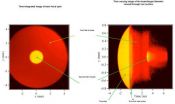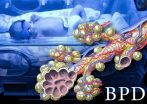(Press-News.org) WINSTON-SALEM, N.C. – March 20, 2013 – New research from Wake Forest Baptist Medical Center is giving radiation oncologists who treat brain tumors a better understanding of how to preserve the brain's functions while still killing cancer.
Ann M. Peiffer, Ph.D., assistant professor of radiation oncology at Wake Forest Baptist, and colleagues looked at how radiation treatment to different brain areas impacts function to help protect cognition for patients during and after radiation therapy and beyond.
Radiation treatment of organs with cancer is designed to give enough of a dose to be toxic to the cancer tumor with minimal impact to the surrounding tissue and avoid normal tissue death. For treatment of organs like the lung, kidney or liver, doctors know exactly how much radiation to give before organ function is affected.
However, the same isn't true for brain tissue, so the researchers worked to develop a "toxicity map" of the brain to preserve function. Peiffer said this is the first attempt to relate treatment dose to brain function, as opposed to brain tissue death. While avoiding normal tissue death is important, it doesn't necessarily help prevent the cognitive and functional problems associated with cancer treatments.
"The issue is the toxicity to the brain and its function, which is cognition or how you think, and these functions are affected at a much lower dose of radiation than what causes tissue death," Peiffer said.
The toxicity map was created by taking advantage of data from larger clinical trials held at Wake Forest Baptist. In one of those trials, 57 brain cancer survivors returned six months or more after their radiation treatment to determine whether Donepezil, a drug normally used to improve mental function for those with early Alzheimer 's disease, was effective at improving their cognition. Participants completed cognitive testing upon enrollment, and their scores provided the performance data for the toxicity map. The researchers then went back into the medical records to match participants to their individual radiation dose levels and MRIs taken prior to treatment, Peiffer said.
"By matching cognitive performance to these measurements, we determined which area of the brain and what dose influenced performance on the cognitive tasks," she said. "This gave us a preliminary look at what areas are important to consider for protecting cognition during our planning for radiation treatment."
Peiffer said by looking at the irradiation dose received by specific brain areas important to different cognitive functions, tolerance levels related to function can be established. The exposed amount of these critical brain areas were then related to outcomes of specific tests used to assess cognition or the ability of the patients to think and perform tasks, such as remembering a grocery list or what a drawing looked like, Peiffer said.
"As technology advances and we are able to spare increasing amounts of normal tissue and important functional structures during treatment, it is important to understand and be able to predict the threshold that we need to maintain to prevent treatment toxicities in function," Peiffer said.
Advances in cancer treatment have increased survivorship rates and the length of time individuals are able to live following treatment, Peiffer said, and quality of life becomes a very important issue for these patients. More research is necessary to validate these data, she said.
###
The research findings were reported in the Februrary Journal of Neurology. The research was supported by grant R01NR009675 from NINR/NIH and U10CA 81851 from NCI/NIH. Individuals were also supported by Wake Forest School of Medicine Medical Student Research Program, Louis Argenta Physician-Scientist Scholarship Fund, NIH T32 CA113267, and the Department of Radiation Oncology.
Co-authors include: C. Marc Leyrer, B.S., Dana M. Greene-Schloesser, Ph.D.; Elaine Shing, B.A.; William T. Kearns, M.S.; William H. Hinson, Ph.D.; Stephen B. Tatter, M.D., Ph.D.; Edward H. Ip, Ph.D.; Stephen R. Rapp, Ph.D.; Mike E. Robbins, Ph.D.; Edward G. Shaw, M.D., M.A.; Michael D. Chan, M.D., all of Wake Forest Baptist.
'Toxicity map' of brain may help protect cognition for cancer patients
2013-03-20
ELSE PRESS RELEASES FROM THIS DATE:
Miriam study reveals financial benefits of a plant-based, Mediterranean diet
2013-03-20
Researchers from The Miriam Hospital and the Rhode Island Community Food Bank report individuals who participated in a six-week cooking program and followed simple, plant-based recipes decreased their total food spending, purchased healthier food items and improved their food security.
The study, published in the March issue of the Journal of Hunger and Environmental Nutrition, is believed to be the first to show a decrease in food insecurity – or a lack of access to nutritional foods for at least some days or meals for members of a household – as the result of an intervention.
Mary ...
'Brain waves' challenge area-specific view of brain activity
2013-03-20
Our understanding of brain activity has traditionally been linked to brain areas – when we speak, the speech area of the brain is active. New research by an international team of psychologists led by David Alexander and Cees van Leeuwen (KU Leuven – University of Leuven) shows that this view may be overly rigid. The entire cortex, not just the area responsible for a certain function, is activated when a given task is initiated. Furthermore, activity occurs in a pattern: waves of activity roll from one side of the brain to the other.
The brain can be studied on various ...
NRL Nike Laser focuses on nuclear fusion
2013-03-20
WASHINGTON--Researchers at the U.S. Naval Research Laboratory have successfully demonstrated pulse tailoring, producing a time varying focal spot size known as 'focal zooming' on the world's largest operating krypton fluoride (KrF) gas laser.
The Nike laser is a two to three kilojoule (kJ) KrF system that incorporates beam smoothing by induced spatial incoherence (ISI) to achieve one percent non-uniformity in single beams and 0.16 percent non-uniformity for 44 overlapped target beams. The facility routinely conducts experiments in support of inertial confinement fusion, ...
CWRU professor offers 'lessons from abroad' on caring for a graying population
2013-03-20
In Norway, families receive public support that enables them to care for aging parents in their own homes and keep them out of nursing homes. This includes a salary for a son or daughter to provide care. They also focus on adapting houses to the needs of older people through municipal government-financed repairs and renovations. The nursing home is the last resort.
In the Netherlands, older people receive a full, government-paid assessment of needs to help them live as independently as possible. They are given a consumer's choice of how to spend an allotment directed ...
Researchers spot molecular control switch for preterm lung disorders
2013-03-20
Researchers at Yale School of Medicine have made major discoveries that could lead to new treatments for lung disorders in premature babies. In a mouse study, the team located key molecules that switch on stress pathways in preterm lung disorders, and also found that when parts of these pathways were blocked with a pain drug, lung damage was prevented or reversed.
The findings are published online ahead of print in the March issue of American Journal of Respiratory Cell and Molecular Biology.
Bronchopulmonary dysplasia (BPD) is the most common chronic lung disease ...
Family dinners nourish good mental health in adolescents
2013-03-20
Regular family suppers contribute to good mental health in adolescents, according to a study co-authored by McGill professor Frank Elgar, Institute for Health and Social Policy. Family meal times are a measurable signature of social exchanges in the home that benefit adolescents' well-being – regardless of whether or not they feel they can easily talk to their parents.
"More frequent family dinners related to fewer emotional and behavioural problems, greater emotional well-being, more trusting and helpful behaviours towards others and higher life satisfaction," says Elgar, ...
FEMA's National Flood Insurance Program needs an updated approach to analyzing flood risk
2013-03-20
WASHINGTON -- In administering the National Flood Insurance Program, the Federal Emergency Management Agency (FEMA) needs a more modern approach to analyzing and managing flood risk behind levees -- one that would give public officials and individual property owners a clearer idea of the risks they face and how they should address them, says a new report from the National Research Council. Because levees can reduce but not eliminate the risk of flooding, the agency should also encourage communities behind levees to use multiple methods to reduce risk and increase awareness ...
Study suggests demographic factors can predict risk of operative births in UK women
2013-03-20
Independent maternal demographic factors such as social status, ethnicity and maternal age can predict the likelihood of operative births in the UK, according to a new study published today (20 March) in BJOG: An International Journal of Obstetrics and Gynaecology.
The study, conducted by researchers in the Department of Health Sciences at the University of York, explores which women are at an increased risk of an operative birth, including caesarean section (CS) or instrumental vaginal birth. It looks at data from the Millennium Cohort Study of babies born in the UK ...
AGU: Voyager 1 has left the solar system, sudden changes in cosmic rays indicate
2013-03-20
WASHINGTON – Thirty-five years after its launch, Voyager 1 appears to have travelled beyond the influence of the Sun and exited the heliosphere, according to a new study appearing online today.
The heliosphere is a region of space dominated by the Sun and its wind of energetic particles, and which is thought to be enclosed, bubble-like, in the surrounding interstellar medium of gas and dust that pervades the Milky Way galaxy.
On August 25, 2012, NASA's Voyager 1 spacecraft measured drastic changes in radiation levels, more than 11 billion miles from the Sun. Anomalous ...
NIST tests underscore potential hazards of green laser pointers
2013-03-20
Using a low-cost apparatus designed to quickly and accurately measure the properties of handheld laser devices, National Institute of Standards and Technology (NIST) researchers tested 122 laser pointers and found that nearly 90 percent of green pointers and about 44 percent of red pointers tested were out of compliance with federal safety regulations. The NIST test apparatus was designed so that it can be replicated easily by other institutions.
As NIST researchers reported at a conference on March 20, 2013,* both red and green laser pointers often emitted more visible ...



